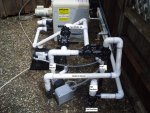Hello,
The attached picture shows new plumbing for a recently-replastered pool/spa combination. I plumbed it in accordance with the Jandy standard plumbing diagram. All new parts. Previously the pool and spa were on completely separate circuits with dedicated pumps and no spillway or intermixing of water. During the replastering job we created a spillway in the spa dam wall so I could eliminate a pump and simplify the chemical balancing, so this is my first time with this new combo configuration.
The current valve positions show normal operation: suction from the pool, return to the pool, and the spa make-up valve open to allow some return water to go to the spa and spill over the spillway into the pool. It works fine when running.
However, sometime after the pump shuts off the check valve in the spa make-up line starts pulsing. You can see it and hear it. It's moving about 1/8 inch about 120 times per minute. This will cause the spa to drain down about an inch overnight, but not any more than that. The spa water level is still well above the pool water level in the morning, and the check valve is no longer pulsing.
I can stop the pulsing by closing the spa make-up valve, but it will start up again when the make-up valve is reopened.
Does anyone have any ideas what could be causing this? I could see the spa draining if the check valve were stuck open, but that doesn't appear to be the case here. How can a spring-loaded check valve pulse unless water was pushing it open from the normal flow direction, and if that were the case why isn't the spa filling instead of draining? There are no air leaks in the system, and everything else works fine.
Thanks..
The attached picture shows new plumbing for a recently-replastered pool/spa combination. I plumbed it in accordance with the Jandy standard plumbing diagram. All new parts. Previously the pool and spa were on completely separate circuits with dedicated pumps and no spillway or intermixing of water. During the replastering job we created a spillway in the spa dam wall so I could eliminate a pump and simplify the chemical balancing, so this is my first time with this new combo configuration.
The current valve positions show normal operation: suction from the pool, return to the pool, and the spa make-up valve open to allow some return water to go to the spa and spill over the spillway into the pool. It works fine when running.
However, sometime after the pump shuts off the check valve in the spa make-up line starts pulsing. You can see it and hear it. It's moving about 1/8 inch about 120 times per minute. This will cause the spa to drain down about an inch overnight, but not any more than that. The spa water level is still well above the pool water level in the morning, and the check valve is no longer pulsing.
I can stop the pulsing by closing the spa make-up valve, but it will start up again when the make-up valve is reopened.
Does anyone have any ideas what could be causing this? I could see the spa draining if the check valve were stuck open, but that doesn't appear to be the case here. How can a spring-loaded check valve pulse unless water was pushing it open from the normal flow direction, and if that were the case why isn't the spa filling instead of draining? There are no air leaks in the system, and everything else works fine.
Thanks..



